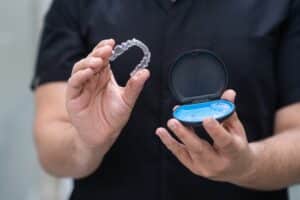
For many people, the word gingivitis sounds like something they have heard but the odds are they don’t know what it describes or how bad it can be if it takes up residence in your mouth.
The reason you don’t want gingivitis camping out in your mouth is that it’s a type of periodontal disease that creates inflammation and infection in your mouth which eventually leads to the destruction of tissue that provide support to your teeth, your gums, periodontal ligaments and tooth sockets.
So how does gingivitis get started? The initial culprit is plaque, that sticky material created from mucus, bacteria and debris from food you eat. It sticks to the areas of your teeth that are exposed and eventually leads to tooth decay.
Once plaque hardens because you didn’t remove it through brushing, flossing and regular visits to your dentist for a cleaning, it becomes tartar (also called calculus). Tartar is a hard deposit that clings to the base of your teeth. Your gums are irritated and inflamed by both plaque and tartar. Then bacteria moves in to your weakened gums, creating toxins that cause your gums to become swollen, tender and eventually infected.
Some amount of gingivitis develops in many people during puberty or their early adult years because of hormonal changes. The gingivitis will often persist or recur periodically if your oral health is poor.
What increases your risk of developing gingivitis?
- Improper dental hygiene
- Certain infections and body-wide (systemic) diseases
- Pregnancy (hormonal changes increase the sensitivity of the gums)
- Uncontrolled diabetes
- Misaligned teeth, rough edges of fillings, and ill-fitting or unclean mouth appliances (such as braces, dentures, bridges, and crowns).
- Use of certain medications, including phenytoin, bismuth, and some birth control pills
What are the symptoms of gingivitis?
- Bleeding gums (blood on toothbrush even with gentle brushing of the teeth)
- Bright red or red-purple appearance to gums
- Gums that are tender when touched, but otherwise painless
- Mouth sores
- Swollen gums
- Shiny appearance to gums
If you do have gingivitis, how is it treated?
The first goal is to reduce the level of inflammation. This is best achieved by making twice-yearly appointments with your dental hygienist for a thorough cleaning of your teeth. Make more frequent appointments if you have severe gingivitis. They’ll loosen and remove deposits of plaque and tartar on your teeth. Of course, in between visits, you need to be sure to brush twice a day and floss daily.
If you are more prone than usual to plaque building up on your teeth, your dentist may recommend special toothpicks, water irrigation, electric toothbrushes, or other devices. Antiplaque and/or anti-tartar toothpastes and mouth washes may also be a good solution for your situation.
Source: ADAM Medical Encyclopedia


